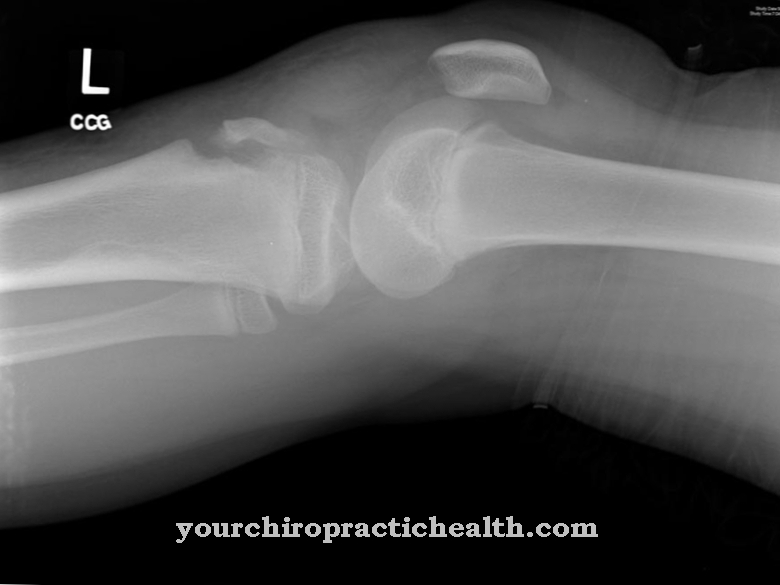The Reinke edema was discovered in 1895 by the anatomist Friedrich Reinke. The benign swelling on the vocal folds leads to impaired speech. If Reinke's edema is not chronic, it can be reduced by taking simple measures such as protecting the voice and giving up smoking and alcohol.
What is Reinke's edema?

© Alila Medical Media - stock.adobe.com
The Reinke edema is a tissue swelling of the vocal folds that leads to impairment of the vocal cords. The tissue water emerging from the capillary vessels collects under their mucous membrane. Reinke's edema can be unilateral or bilateral. The thickening of the vocal cords restricts the movement of the vocal folds in the airflow.
This leads to a hoarse voice (dysphonia). In extreme cases it fails (aphonia) or slips in the pitch of the voice. Reinke's edema mostly affects women between 40 and 60 years of age. It can appear as acute edema when, for example, the voice is briefly overloaded. In such a case, the watery-transparent swelling usually disappears a few hours later.
Inflamed edema is no longer transparent, but reddened. If they are chronic and are not surgically removed, nodules can appear on the vocal cords that lead to loss of voice.
causes
How Reinke's edema develops is still unclear. However, risk factors are heavy smoking for years and excessive alcohol consumption. In addition, excessive or incorrect voice strain (singer, teacher) is the cause. People who are exposed to fine dust, chemical vapors and other substances that irritate the respiratory tract for a longer period of time for professional reasons are also at increased risk of developing Reinke's edema.
Recent clinical studies show that there may even be a hormone-related connection between the storage of hyaluronic acid in the vocal fold epithelium and the development of Reinke's edema. If the wrong breathing technique is used, the vocal cords are also stressed. The influence of gastric acid (reflux) rising in the oropharynx has not yet been clarified. Indoor air that is too dry also makes things more difficult.
Symptoms, ailments & signs
The swelling of the vocal folds causes a slightly harsh to extremely hoarse voice, depending on the extent of the swelling. Sometimes it is also deeper than usual. Those affected find prolonged speaking to be too strenuous and therefore often neglected. In the case of severe edema, it can even lead to a loss of voice or the voice tips over, as in pubertal voice breakage.
If the glottis becomes even more narrow, breathing problems (shortness of breath) are the result. This leads to reflux, increased mucus formation, frequent coughing, pressure and a lump in the throat. Since the flow of the voice is hindered by the narrowing of the glottis, patients with Reinke's edema have additional articulation difficulties. Sometimes the disease also appears as a symptom in the context of chronic, unspecific laryngitis.
Diagnosis & course of disease
In Reinke's edema, the neck lymph nodes and the larynx are palpated to rule out a sore throat. Then a detailed examination of the oropharynx and the vocal cords is carried out with the help of a laryngoscopy. A tissue removal (biopsy) is used to rule out other causes such as granuloma, infiltration or malignant tumors.
Complications
Reinke's edema can lead to hoarseness or even loss of voice, depending on the extent of the swelling. Further narrowing of the glottis leads to breathing problems such as shortness of breath and shortness of breath. In addition, increased mucus formation, whooping cough and the familiar lump in the throat can occur. The narrowing of the glottis often results in articulation difficulties.
If the disease occurs as a symptom of chronic, non-specific laryngitis, severe inflammation and acute shortness of breath can also occur. Persistent voice disorders cannot be ruled out, depending on the extent of the inflammation. If bacteria are the cause of the laryngitis, the inflammation can spread. Abscesses and phlegmon form in the larynx. In connection with Reinke's edema, severe pain and other complications often arise.
The treatment of Reinke's edema via stripping results in visible scars. Typically there are bruises, hardening and occasionally infections and wound healing disorders. In addition to these operational risks, lymph and nerve injuries can also occur during stripping. If nerves are injured, this can lead to sensory disorders. The Arum triphyllum C5 globules prescribed to accompany the procedure can cause inflammation of the mucous membrane if the dosage is incorrect.
When should you go to the doctor?
Reinke's edema should always be treated by a doctor. Only through early diagnosis and treatment can further complaints be avoided, so that the life expectancy of the person affected is not restricted. In the case of Reinke's edema, a doctor should be consulted if the patient has a very hoarse or rough voice over and over and can therefore only speak deeply.
In severe cases, a complete loss of voice can occur, and some of those affected suffer a voice break. Shortness of breath can also be an indication. Persistent heartburn can also indicate Reinke's edema and should be examined by a doctor if the symptoms persist and do not go away on their own.
In the first place, Reinke's edema can be examined and treated by an ENT doctor. In serious cases, however, preventive examinations for cancer are also useful in order to detect and treat it early. As a rule, the life expectancy of the person affected is not negatively influenced by Reinke's edema and the disease progresses positively.
Therapy & Treatment
Severe chronic Reinke edema, in which breathing is also restricted, must be surgically removed. This is done with the help of stripping: The phonosurgeon removes the tissue swelling after local or general anesthesia with the help of tiny forceps or laser technology.
Local anesthesia only is more suitable, as the patient is still awake during the operation and his voice can then be better assessed: The vibrational behavior of the vocal fold mucosa can then be controlled stroboscopically. Whether the operation has brought the desired success can be determined two to three months after the operation at the earliest, as the wound healing process is only then fully completed.
If both vocal folds are affected by the edema, the patient's voice will not return to normal until the second has also been operated on. With the same anesthetic, both vocal folds can only be operated on if the swellings are insignificant: otherwise they could grow together during the healing process. If the operation is performed under general anesthesia, the patient must remain in the clinic for three to six days.
After the surgery, he should immediately undergo speech therapy voice therapy to improve speaking, breathing technique and posture. Acute cases of Reinke's edema are treated by the ENT doctor with a spray containing cortisone. In addition, the person concerned should definitely stop smoking and limit his alcohol consumption. The same goes for the time after surgery.
If the patient starts smoking or drinking alcohol again, the vocal folds will swell again. As a general rule, the person affected should take care of their voice - regardless of whether they only have acute or minor chronic edema or have just had an operation. Smaller swellings can even be treated homeopathically.
The patient takes 5 globules of Arum triphyllum C5 orally every hour. If the symptoms subside, take it at longer intervals and stop when the symptoms have subsided. The patient should strictly adhere to the dosage, otherwise inflammation of the mucous membranes can occur.
You can find your medication here
➔ Medicines for hoarsenessprevention
For people who have to speak and sing a lot at work, prevention could consist in drinking a lot of fluids, only using their voice more often in warm rooms and always sucking Emser Salz pastilles in between. They should also not smoke and consume little alcohol.
You can do that yourself
Reinke's edema usually has to be removed surgically. The vocal folds are subsequently irritated and must not be irritated by speaking or eating irritating foods. The patient should work out a suitable diet together with a nutritionist and the responsible doctor. The nutrition plan must be followed consistently to avoid irritation of the vocal cords.
At the same time, the triggers for the suffering must be removed. If the cause is the consumption of alcohol or cigarettes, these substances should not be used. Small swellings can sometimes be treated homeopathically.It is best for the patient to contact an alternative health professional so that appropriate therapy can be initiated. For example, the globules Arum triphyllum C5, which can be taken independently in consultation with the family doctor, is effective. As the symptoms subside, the doctor-prescribed dose can be gradually reduced. The patient must strictly adhere to the dosage. Otherwise it can lead to an inflammation of the mucous membranes, which is associated with considerable health problems.
Reinke's edema is not a serious disease, but requires constant monitoring by a specialist. After completing the initial treatment, regular follow-ups are indicated. It is best for the patient to contact a specialist and inform him of any symptoms and complaints.
Aftercare
The extent to which follow-up care is necessary depends on whether the typical symptoms of Reinke's edema can be completely eliminated. If this succeeds, no further treatments are necessary in view of the absence of symptoms. In all other cases there is a need for long-term treatment. In view of the threat of a loss of voice, medical support is particularly important in speaking professions.
In it, those affected learn how to deal with a wide variety of behaviors and exercises to prevent or reduce renewed fluid accumulation. You have to do this yourself. Avoiding fine dust and quitting smoking are essential. Patients also take part in speech therapy sessions, through which they avoid improper stress on the vocal cords.
How long scheduled follow-up examinations are necessary and how intensive they must be depends on the degree of the symptoms. The question of unilateral and bilateral localization of the complaints also plays a role. In principle, the control also serves to discuss a surgical intervention. However, this is usually the last conceivable measure.
Doctors usually trust speech therapy. Usually they lead to the desired success of the treatment. The pharynx is extensively inspected as part of an examination. The main focus is on the vocal cords, which are examined using laryngoscopy.

.jpg)




.jpg)

.jpg)



















